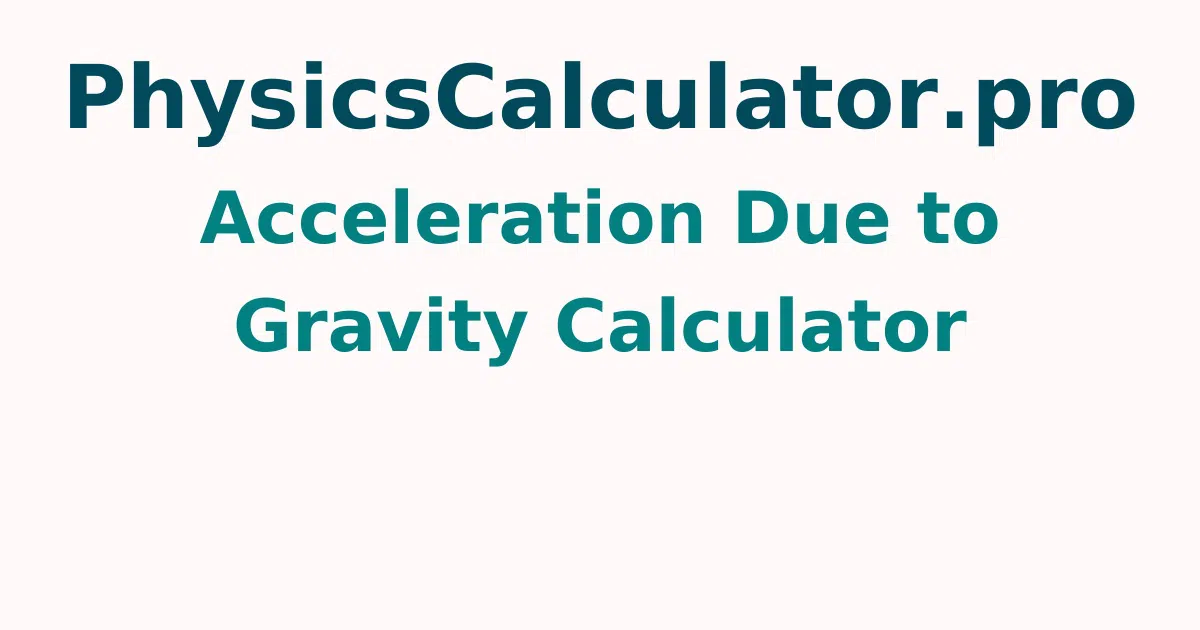Acceleration Due to Gravity Calculator
Use our time-saving Acceleration Due to Gravity Calculator to quickly calculate the acceleration due to gravity value for the given numbers. Just enter the values for mass, radius, and gravitational acceleration in the appropriate sections and press the calculate button to get an instant result.
What is Gravitational Acceleration?
Gravitational acceleration is also known as gravity acceleration. It indicates that an object's velocity changes when it falls from a specific height to the earth's surface. The gravitational acceleration is the change in velocity that causes the object to accelerate. The universal gravitational constant is 6.674×10^-11 m^3⋅kg^-1.s^-2.
Gravity's acceleration (g): The acceleration imparted to a body in a vacuum by gravity, defined as the geometric sum of the planet's gravitational pull (or that of another celestial body) plus inertial forces due to spin. The acceleration of gravity equals the force of gravity acting on a unit mass object, according to Newton's second law. Gravitational acceleration has two parts: gravitational and centrifugal acceleration. Only the gravitational acceleration is evaluated by the calculator.
By visualising the planet as a point mass M and calculating the gravitational acceleration at a distance of its radius R, the value of the gravitational acceleration on the surface can be estimated using the formula g = G M/(R+h)2
- Where, G = gravitational constant
- h = altitude above sea level
- R = radius
- M = mass
How to Calculate Gravitational Acceleration?
To calculate the acceleration due to gravity, follow the steps below. By following the above-mentioned recommendations, you will be able to arrive at a simple answer.
From the given question, calculate the planet's mass, radius from the planet's centre, and gravitational acceleration. The formula for calculating Gravitational Acceleration is GM/r2
- Where m is the mass
- r is the radius of the planet
- G is the universal gravitational constant.
Put in the values in the formula and do the calculations
How to Use the Gravitational Acceleration Calculator?
The following is the procedure how to utilize the acceleration due to gravity calculator
- Fill in the unknown value's mass, radius, and "x" in the appropriate input fields.
- To calculate the acceleration due to gravity, click the "Calculate the Unknown" button.
- Finally, in the output field, the gravitational acceleration will be displayed.
Real-life Examples of Acceleration Due to Gravity
- Planets and other celestial bodies have satellites around them. The gravitational force is responsible for the moon and the earth.
- When a tissue paper and a steel bottle are dropped at the same moment, the bottle falls quicker than the tissue paper due to the direct proportionality of the mass of the bottle, which is more than that of the tissue paper.
- The fruit falls off the tree after it has been ripped. The height of the thing falls as the mass of the object grows.
Examples on Finding Acceleration Due to Gravity
Question 1: The radius of the moon is 1.62×10^6m. The mass of the moon is taken as 8.25×10^22 kg. Calculate the gravitational acceleration on the moon's surface.
Solution:
The distance to the centre of mass on the moon's surface will be the same as the radius.
r = 1.62×106 m.
m = 8.25×1022 kg
G = 6.673×10-11
The formula below can be used to calculate the acceleration due to gravity on the moon's surface: g = GM / r2
g = 6.673×10-11 ×8.25×1022 / (1.62×10^6)2
= 2.09 ms2
Question 2: What is the gravitational acceleration on the Moon's surface? The mass of the Moon is 8.62 x 1022 kg, its radius is 1.9 x 106 m, and the universal constant is 6.67 x 1010-11 Nm2/kg2.
Solution:
Given: r = 1.9 x 106 m
m = 8.62 x 1022 kg
G = 6.673×10-11 Nm2/kg2
The formula below can be used to calculate the acceleration due to gravity on the moon's surface: g = GM / r^2
g = 6.673×10-11 ×8.62×1022 / (1.9×10^6)2
g = 1.59 ms2
For more concepts check out physicscalculatorpro.com to get quick answers by using this free tool.
FAQs on Acceleration Due to Gravity Calculator
1. What do g M and R stand for?
The weight of an object on Earth equals the gravitational force exerted by the Earth on that object. G is the gravitational constant, M is the mass of the Earth, and R is the radius of the Earth.
2. Why is G referred to as universal gravitational constant?
G is known as the universal constant because its value remains constant throughout the world and is unaffected by object masses. The value of the G will be constant everywhere in the Universe since the capital G will be constant.
3. What is the difference between gravity and gravitation?
Gravitation is the force that acts between two bodies. Gravity, on the other hand, is the force that exists between an object and the very large object known as the earth. Gravitation is also defined as a force that is proportional to the product of the masses of both objects.
4. What do you mean by gravitational acceleration?
The gravitational acceleration is the acceleration gained by an object as a result of the gravitational attraction between two objects. The S.I unit of gravity and acceleration are the same, ms^-2 is used. The earth's gravitational acceleration is a standardized value indicated by (g).
5. What is the average value of gravity's acceleration?
The acceleration due to gravity is the acceleration created in a body as it falls freely under gravity due to the Earth's gravitational acceleration. It is characterized by the letter g. g has an average value of 9.8 m/s^2.
